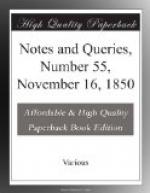“Quum vero praedicator indefensus, missionum ecclesiasticarum causa, in borealibus versaretur partibus, miraculum ibi stupendum sane patravit. Conspexit enim taurum ingentem, vaccarum (sicut poeta quidam ex ethnicis ait) ‘magna comitante caterva,’ in prato quodam graminoso ferocientem, maceria tantum bassa inter se et belluam istam horrendam interposita. Constitit Thomas, constitit et bos, horribiliter rugiens, cauda erecta, cornibus immaniter saeviens, ore spumam, naribus vaporem, oculis fulgur emittens, maceriam transsilire, in virum sanctum irruere, corpusque ejus venerabile in aera jactitare, visibiliter nimis paratus. {407} Thomas autem, eapta occasione, oculos in monstrum obfirmat, signumque crucis magneticum in modum indesinenter ducere aggreditur, En portentum inauditum! geminis belluae luminibus illico palpebrae obducuntur, titubat taurus, cadit, ac, signo magnetico sopitus, primo raucum stertens, mox infantiliter placidum trahens halitum, humi pronus recumbit. Nec moratus donec hostis iste cornutus somnum excuteret, viv sanctus ad hospitium se propinquum laetus inde incolumisque recepit.”
RUSTICUS.
“Her Brow was fair.”—Can any of your many readers inform me of the author of the following lines, which I copy as I found them quoted in Dr. Armstrong’s Lectures:
“Her brow was fair, but very pale,
And looked like stainless marble; a touch
methought would soil
Its whiteness. On her temple, one
blue vein
Ran like a tendril; one through her shadowy
hand
Branched like the fibre of a leaf away.”
J.M.B.
Hoods warn by Doctors of Divinity of Aberdeen.—Will you allow me to inquire, through the pages of your publication, of what colour and material the exterior and lining of hoods were composed which Doctors in Divinity, who had graduated at Aberdeen, Glasgow, and St. Andrew’s, prior to the Reformation, were accustomed to wear? I imagine, the same as those worn by Doctors who had graduated at Paris: but what hoods they wore I know not. I trust that some of your correspondents will enlighten me upon this subject.
LL.D.
Irish Brigade.—Where can I find any account of the institution and history of the Irish brigade, a part of the army of France under the Bourbons?
J.D.
Bath.
Doctrine of the Immaculate Conception.—In the charge delivered by the Bishop of London to his clergy, on the 2nd instant, the following passage occurs:
“It is not easy to say what the members of that Church [the Church of Rome] are required to believe now; it is impossible for men to foresee what they may be called upon to admit as an article of faith next year, or in any future year: for instance, till of late it was open to a Roman Catholic to believe or not, as he might see reason, the fanciful notion of the immaculate conception of the Blessed Virgin; but the present Bishop of Rome has seen fit to make it an article of their faith; and no member of his church can henceforth question it without denying the infallibility of his spiritual sovereign, and so hazarding, as it is asserted, his own salvation.”
Can any of your correspondents inform me where the papal decision on this point is to be found?




